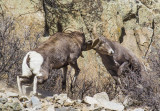
How much would you pay to hunt any season, any weapon, any species? Your dream hunt, dream unit, and all the time in the world to get it done. $10,000? $50,000?
Try $370,000. That’s how much the state of Oregon received this year after a “governor’s” tag auction for a coveted sheep tag. Most western states have some variation of a governor’s tag, albeit under different names. The premise is the same: the state sets aside a handful of big-game tags—usually some combination of sheep, elk, deer, and goat—to be auctioned off to the highest bidders.
Secondary to standard tag lottery systems, governor’s tags provide a means to raise money for conservation and wildlife initiatives that would otherwise be infeasible. Such a small number of so-called “once-in-a-lifetime” tags are given out annually through the ordinary sheep, moose, and goat draws, but the revenue from those sales doesn’t even come close to that generated by governor’s tags. In Montana, for example, Fish, Wildlife & Parks gave away 198 bighorn tags through the big-game draw in 2022 (excluding unlimited sheep hunts, but including ewe tags). At $125 per tag (for residents), they brought in $24,750 in license revenue from the species. That same year, Montana sold a single governor’s sheep tag for $360,000 through the Wild Sheep Foundation.
Montana also holds the record for all-time most expensive sheep tag, with a highest bid in 2013 of $480,000. The winning bidder, however, reportedly backed out after a dispute with his wife. The tag went to the second-highest bidder, and the original winner agreed to pay the difference.
In all states that hold governor’s tag sales, the auctions are conducted by sponsoring conservation organizations. The organizations are usually allowed to keep a portion of the profits (10% in Oregon, for example), while the remainder is earmarked for conservation and returned to the state wildlife agency.
Since the conception of the tags in the ’80s and ’90s, auction prices have slowly been creeping upward. When Oregon started the auction in 1995, a measly $73,000 took home a sheep tag. In 1986 in Montana, a bid of $76,000 secured the tag.
More recent auctions held at hunting expos have raised millions of dollars for conservation in only a few hours. In 2017, for example, the 11th annual Western Hunting and Conservation Expo raised over $1 million on their five highest-selling hunts: $280,000 for a mule deer buck hunt in Arizona, $250,000 for a mule deer hunt in Utah, $180,000 for a statewide mule deer hunt in Utah, $170,000 for five species in New Mexico, and $130,000 for a statewide mule deer permit in Nevada.
At the 2023 expo in Salt Lake City, bidders took home what might be the two most expensive tags ever sold: a $500,000 Utah “Antelope Island” mule deer tag (one of only two given out annually for a state-owned island in the Great Salt Lake, known for its monster bucks), and a staggering $725,000 Arizona mule deer tag. The Arizona winner can hunt bucks for an entire calendar year.
Unsurprisingly, over the years there has been some unscrupulous behavior surrounding the hunts. In 2015, Washington resident Tod Reichert was charged with using his governor’s tag to shoot a locally famous town elk nicknamed “Bullwinkle” in a restricted area outside of Ellensburg, WA. He then reportedly transported the animal to a legal area before field dressing it. The charges, however, were subsequently dismissed on the grounds of a technicality related to the legal definition of a “branch antlered” elk in Washington.
That wasn’t Reichert’s first run-in with trouble. In 2007, Reichert purchased the Eastside Washington governor’s elk tag for $47,000. Then he proceeded to hire a helicopter pilot to spot elk (a wildlife violation in WA), and an outfitter not legally authorized to operate in the area. Then again, in 2008, Reichert hired the same illegal outfitter for another governor’s tag. As a result, he was fined $5,000 and prohibited from entering National Forest lands for two years.
But for the most part, tag-holders appear to play by the rules—the few that there are. While some states like Wyoming and Colorado require license holders to select a single season to hunt (i.e. archery elk or second season rifle mule deer), others, like Oregon, allow for hunting on all tags between August 1 and November 30 with any legal weapon in any district. Essentially, they guarantee the tag holder a trophy of a lifetime.
As such, some view the trophy hunts as unfair opportunities for wealthy out-of-state landowners to secure coveted tags that often take ordinary hunters decades to pull. In response, some states (like Montana and Wyoming), have implemented comparable “Super Tag” raffles, giving out similar licenses through raffles that typically cost between $5 and $25 to enter. It’s not quite the guarantee of dropping $400,000 on a tag, but it gives folks of ordinary means a fighting chance, no matter how small it may be.
In the meantime, keep putting your name in the hat, and eventually you might just pull that tag of a lifetime, at a fraction of the market-value cost that the governor’s tag auctions command.





Conversation